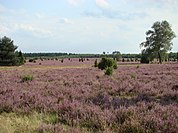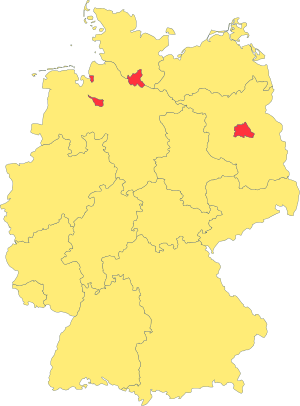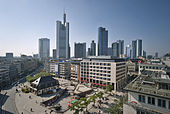Geography of Germany
51°00′N 10°00′E / 51.00°N 10.00°E


Germany is a country in Central Europe, stretching from the Alps, across the North European Plain to the North Sea and the Baltic Sea. Germany has the second largest population in Europe (after the European part of Russia) and is seventh largest in area. The territory of Germany covers 357,021 km2 (137,847 sq mi), consisting of 349,223 km2 (134,836 sq mi) of land and 7,798 km2 (3,011 sq mi) of water.
Elevation ranges from the mountains of the Alps (highest point: the Zugspitze at 2,962 metres (9,718 ft) in the south to the shores of the North Sea (Nordsee) in the northwest and the Baltic Sea (Ostsee) in the northeast. Between lie the forested uplands of central Germany and the low-lying lands of northern Germany (lowest point: Neuendorf-Sachsenbande at 3.54 metres (11.6 ft) below sea level), traversed by some of Europe's major rivers such as the Rhine, Danube and Elbe.[1]
Germany shares borders with nine European countries, second only to Russia: Denmark in the north, Poland and the Czech Republic in the east, Austria and Switzerland in the south, France in the southwest and Belgium, Luxembourg and the Netherlands in the west.
Area
Germany is in Western and Central Europe, bordering Denmark in the north, Poland and the Czech Republic in the east, Austria and Switzerland in the south, France and Luxembourg in the south-west, and Belgium and the Netherlands in the north-west. It lies mostly between latitudes 47° and 55° N (the tip of Sylt is just north of 55°), and longitudes 5° and 16° E. The territory covers 357,021 km2 (137,847 sq mi), consisting of 349,223 km2 (134,836 sq mi) of land and 7,798 km2 (3,011 sq mi) of water. It is the seventh largest country by area in Europe and the 63rd largest in the world.[1]
Extreme points
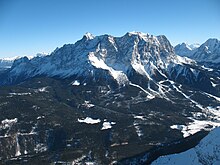
- northernmost point: List, Sylt, Schleswig-Holstein 55°03′N 8°24′E / 55.050°N 8.400°E
- northernmost point in mainland Germany: Aventoft, Schleswig-Holstein 54°54′N 8°49′E / 54.900°N 8.817°E
- southernmost point: Haldenwanger Eck, Oberstdorf, Bavaria 47°16′12.39″N 10°10′41.95″E / 47.2701083°N 10.1783194°E
- westernmost point: Isenbruch, Selfkant, North Rhine-Westphalia 51°1′N 5°53′E / 51.017°N 5.883°E
- easternmost point: Deschka, Neißeaue, Saxony 51°16′N 15°2′E / 51.267°N 15.033°E
- lowest point: Wilstermarsch 3.53 m below sea level 53°57′48″N 9°19′05″E / 53.96333°N 9.31806°E
- highest point: Zugspitze (in the Bavarian Alps, 2,962 m 47°25′N 10°59′E / 47.417°N 10.983°E
Maritime claims
- Continental shelf: 200 m depth or to the depth of exploitation
- Exclusive economic zone: 200 nmi (370.4 km; 230.2 mi). The exact EEZ is due to conventions with neighbouring states.
- Territorial sea: 12 nmi (22.2 km; 13.8 mi)
Physical Geography

The northern third of the country lies in the North European Plain, with flat terrain crossed by northward-flowing watercourses (Elbe, Ems, Weser, Oder). Wetlands and marshy conditions are found close to the Dutch border and along the Frisian coast. Sandy Mecklenburg in the northeast has many glacier-formed lakes dating to the last glacial period.
Moving south, central Germany features rough and somewhat patternless hilly and mountainous countryside, some of it formed by ancient volcanic activity. The Rhine valley cuts through the western part of this region. The central uplands continue east and north as far as the Saale and merge with the Ore Mountains on the border with the Czech Republic. Upland regions include the Eifel, Hunsrück and Palatine Forest west of the Rhine, the Taunus hills north of Frankfurt, the Vogelsberg massif, the Rhön, and the Thüringer Wald. South of Berlin, the east-central part of the country is more like the low northern areas, with sandy soil and river wetlands such as the Spreewald region.
Southern Germany's landforms are defined by various linear hill and mountain ranges like the two adjacent ranges of the Swabian and Franconian Alb (reaching approximately from the source of the Danube in the southwest of Baden-Württemberg, south of Stuttgart, across Swabia into Central Franconia and to the valley of the river Main) and the Bavarian Forest along the border between Bavaria and the Czech Republic. The Alps on the southern border are the highest mountains, but relatively little Alpine terrain lies within Germany (in southeastern Swabia and Upper Bavaria) compared to Switzerland and Austria. The Black Forest, on the southwestern border with France, separates the Rhine from the headwaters of the Danube on its eastern slopes.
Climate
Germany's climate is temperate and marine, with cool, cloudy, wet winters and summers and in the south occasional warm föhn wind. The greater part of Germany lies in the cool/temperate climatic zone in which humid westerly winds predominate. In the northwest and the north the climate is extremely oceanic and rain falls all the year round. Winters there are relatively mild and summers comparatively cool. In the east the climate shows clear continental features; winters can be very cold for long periods, and summers can become very warm. Dry periods are often recorded.
In the centre and the south there is a transitional climate which may be predominantly oceanic or continental, according to the general weather situation. Winters are mild and summers tend to be cool, though maximum temperatures can exceed 30 °C (86 °F) for several days in a row during heat waves. The warmest regions of Germany can be found in the south-west (see rhine rift, German Wine Route and Palatinate). Here summers can be hot with a high number of days exceeding 30 °C (86 °F). Sometimes minimum temperatures don't drop under 20 °C (68 °F), which is relatively rare in other regions.[2][3]
.
Land use
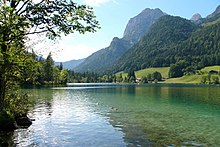
Germany covers a total of 357,021 km², of which 4,750 km² is irrigated land and 7,798 km² is covered by water, the largest lakes being Lake Constance (total area of 536 km², with 62% of the shore being German; international borders are not defined on the lake itself), Müritz (117 km²) and Chiemsee (80 km²). The majority of Germany is covered by either arable land (33%) or forestry and woodland (31%). Only 15% is covered by permanent pastures.
Germany has a total of 2,389 km of coastline, and borders totalling 3,621 km (clockwise from north: Denmark 68 km, Poland 456 km, Czech Republic 815 km[4], Austria 784 km, Switzerland 334 km, France 451 km, Luxembourg 138 km, Belgium 167 km, Netherlands 577 km). The German-Austrian border crosses itself near Jungholz. The border with Belgium includes 5 German exclaves because the Vennbahn railway is on Belgian territory crossing in and out of Germany.
Rivers
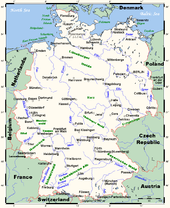
The main rivers in Germany are:
- the Rhine (Rhein in German) with a German part of 865 km (main tributaries including the Neckar, the Main and the Moselle (Mosel));
- the Elbe with a German part of 727 km (also drains into the North Sea); and
- the Danube (Donau) with a German part of 687 km.
Further important rivers include the Isar in the southeast, the Main in central Germany, the Neckar in the southwest, and the Weser in the North. See also the list of rivers in Germany.
Caves
Throughout the Karst rocks many caves were formed especially in the valley of the Hönne. The biggest culture cave of Europe is located in Balve.
Natural resources
- Iron ore, coal, potash, timber, lignite, uranium, copper, natural gas, salt, nickel, arable land, water
Environment
- Current issues
- Emissions from coal-burning utilities and industries contribute to air pollution; acid rain, resulting from sulphur dioxide emissions, is damaging forests; pollution in the Baltic Sea from raw sewage and industrial effluents from rivers in eastern Germany; hazardous waste disposal; government (under Chancellor Schröder, SPD) announced intent to end the use of nuclear power for producing electricity; government working to meet EU commitment to identify nature preservation areas in line with the EU's Flora, Fauna, and Habitat directive. Germany's last glacier is disappearing. [1]
- International agreements
- Party to: Air Pollution, Air Pollution-Nitrogen oxides, Air Pollution-Sulphur 85, Air Pollution-Sulphur 94, Air Pollution-Volatile Organic Compounds, Antarctic-Environmental Protocol, Antarctic Treaty, Biodiversity, Climate Change, Climate Change-Kyoto Protocol, Desertification, Endangered Species, Environmental Modification, Hazardous Wastes, Law of the Sea, Marine Dumping, Nuclear Test Ban, Ozone Layer Protection, Ship Pollution, Tropical Timber 83, Tropical Timber 94, Wetlands, Whaling
- Signed, but not ratified: Air Pollution-Persistent Organic Pollutants
- Natural hazards
- Flooding through rivers after heavy rainfall, such as during the 2002 European floods, or Storm surge, such as the North Sea flood of 1962 or the historic floods of 1634 and 1362 that changed the coastline of what is now the west coast of Schleswig-Holstein.
Flora and Fauna
Phytogeographically, Germany is shared between the Atlantic European and Central European provinces of the Circumboreal Region within the Boreal Kingdom. The territory of Germany can be subdivided into two ecoregions: European-Mediterranean montane mixed forests and Northeast-Atlantic shelf marine.[5] The majority of Germany is covered by either arable land (33%) or forestry and woodland (31%). Only 15% is covered by permanent pastures.
Plants and animals are those generally common to middle Europe. Beeches, oaks, and other deciduous trees constitute one-third of the forests; conifers are increasing as a result of reforestation. Spruce and fir trees predominate in the upper mountains, while pine and larch are found in sandy soil. There are many species of ferns, flowers, fungi, and mosses. Fish abound in the rivers and the North Sea. Wild animals include deer, wild boar, mouflon, fox, badger, hare, and small numbers of beaver. Various migratory birds cross Germany in the spring and autumn.
The national parks in Germany include the Wadden Sea National Parks, the Jasmund National Park, the Vorpommern Lagoon Area National Park, the Müritz National Park, the Lower Oder Valley National Park, the Harz National Park, the Saxon Switzerland National Park and the Bavarian Forest National Park.
Germany is known for its many zoological gardens, wildlife parks, aquaria, and bird parks.[6] More than 400 registered zoos and animal parks operate in Germany, which is believed to be the largest number in any single country of the world.[7] The Zoologischer Garten Berlin is the oldest zoo in Germany and presents the most comprehensive collection of species in the world.[8]
Human Geography
Demographics

With estimated 81.8 million inhabitants in January 2010, Germany is the most populous country in the European Union and ranks as the 15th largest country in the world in terms of population. Its population density stands at 229.4 inhabitants per square kilometer. The United Nations Population Fund lists Germany as host to the third-highest number of international migrants worldwide,[9] around 20% of Germany´s population do not hold a German passport or are descendents of immigrants.
Administrative divisions
Germany comprises sixteen states that are collectively referred to as Länder.[10] Each state has its own state constitution[11] and is largely autonomous in regard to its internal organisation. Due to differences in size and population the subdivision of these states varies, especially between city states (Stadtstaaten) and states with larger territories (Flächenländer). For regional administrative purposes five states, namely Baden-Württemberg, Bavaria, Hesse, North Rhine-Westphalia and Saxony, consist of a total of 22 Government Districts (Regierungsbezirke). As of 2009 Germany is divided into 403 districts (Kreise) on municipal level, these consist of 301 rural districts and 102 urban districts.[12]
|
Urbanization
Germany has a number of large cities; the most populous are: Berlin, Hamburg, Munich, Cologne, Frankfurt, and Stuttgart. The largest conurbation is the Rhine-Ruhr region (12 million), including Düsseldorf (the capital of North Rhine-Westphalia), Cologne, Essen, Dortmund, Duisburg, and Bochum.
| Rank | City | State | Population | ||
|---|---|---|---|---|---|
| 1 | Berlin | Berlin | 3,439,100 | ||
| 2 | Hamburg | Hamburg | 1,769,117 | ||
| 3 | Munich | Bavaria | 1,330,440 | ||
| 4 | Cologne | North Rhine-Westphalia | 998,105 | ||
| 5 | Frankfurt am Main | Hesse | 671,927 | ||
| 6 | Stuttgart | Baden-Württemberg | 600,068 | ||
| 7 | Düsseldorf | North Rhine-Westphalia | 586,217 | ||
| 8 | Dortmund | North Rhine-Westphalia | 581,308 | ||
| 9 | Essen | North Rhine-Westphalia | 576,259 | ||
| 10 | Bremen | Bremen (state) | 547,685 | ||
| 11 | Hanover | Lower Saxony | 520,966 | ||
| 12 | Leipzig | Saxony | 518,862 | ||
| 13 | Dresden | Saxony | 517,052 | ||
| 14 | Nuremberg | Bavaria | 503,673 | ||
| 15 | Duisburg | North Rhine-Westphalia | 491,931 | ||
| Destatis (2009)[13] |
See also
References
- ^ a b Germany CIA Factbook. November 14, 2006. Retrieved November 29, 2006.
- ^ German Climate Handbuch Deutschland. Retrieved November 30, 2006.
- ^ German Climate and Weather World Travels. Retrieved November 30, 2006.
- ^ "CIA - The World Factbook -- Germany". The World Factbook. Central Intelligence Agency. updated May 31, 2012. Retrieved 2012-05-31.
{{cite web}}: Check date values in:|date=(help) - ^ List of Ecoregions: Terrestrial Ecoregions WWF. Retrieved 21 November 2000.
- ^ List of famous Zoological gardens in European countries www.eupedia.com. Retrieved 17 October 2008.
- ^ Some interesting zoo facts www.americanzoos.info/. Retrieved 17 October 2008.
- ^ Template:De iconTierstatistik 2008[dead link], Zoo Berlin. Retrieved 19 November 2009.
- ^ "International Migration 2006" (PDF). UN Department of Economic and Social Affairs. Retrieved 18 March 2011.
- ^ The individual denomination is either Land [state], Freistaat [free state] or Freie (und) Hansestadt [free (and) Hanseatic city].
"The Federal States". www.bundesrat.de. Bundesrat of Germany. Retrieved 17 July 2011.
"Amtliche Bezeichnung der Bundesländer" (PDF; download file „Englisch“). www.auswaertiges-amt.de (in German). Federal Foreign Office. Retrieved 22 October 2011.{{cite web}}: Unknown parameter|trans_title=ignored (|trans-title=suggested) (help) - ^ "Example for state constitution: "Constitution of the Land of North Rhine-Westphalia"". Landtag (state assembly) of North Rhine-Westphalia. Retrieved 17 July 2011.
- ^ "Kreisfreie Städte und Landkreise nach Fläche und Bevölkerung 31.12.2009" (XLS) (in German). Statistisches Bundesamt Deutschland. 2010. Retrieved 26 September 2011.
{{cite web}}: Unknown parameter|month=ignored (help) - ^ "Statistisches Bundesamt Deutschland – Startseite". Destatis.de. 20 October 2008. Retrieved 26 September 2010.
External links
- Kostenlose Deutschland-Karten
- Geoberg.de: Geologie Deutschlands – Fotografien geologischer Objekte aus Deutschland
- mineralienatlas.de: Reiches Erz aus dem Harz
- Deutscher Klimaatlas



